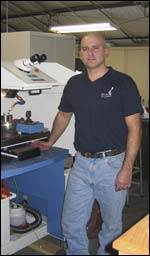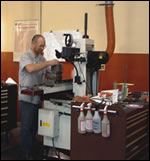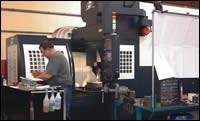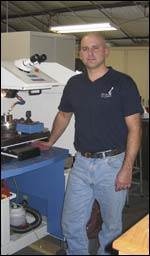A.J. Tool Co. Inc.: Niche Moldmaking Meets High Expectations
Top-notch customer service combined with loyal, hardworking employees that work together toward continuous improvement land this moldmaker the MoldMaking Technology 2006 Leadtime Leader Award: Small Shop.
With just under $5 million in annual sales last year, the 28 employees of A.J. Tool Co. Inc. (Hubertus, WI) have shown that niche marketing, banding together and working hard to realize a common goal have resulted in leadtimes of anywhere from three to four weeks to eight weeks—and a 10 percent average annual sales growth over the past three years.
Finding that niche has been a critical factor in A.J. Tool’s success. “We’ve targeted three areas that we feel very comfortable with—two-shot, auto-unscrewing and complex multi-action tools,” explains General Manager Dan Ebert. “We 're able to compete in these areas because we have sought out customers who want to buy these higher end molds. We have found customers that understand the difference between cost and overall value—customers that have accurately measured the cost of their molds over the entire mold life versus that of the initial purchase price.” These customers have told Ebert that buying a high quality mold upfront has been more cost effective for them in the long run.
The company also specializes in the design and building of plastic injection molds, thermoset injection and compression molds, and conventional die-cast molds—and also provides special machining services for die sets or custom machining jobs. Industries served include medical, automotive, marine, communications/electronics, consumer products, lawn and garden, packaging, industrial appliance and more.
Beginning the Journey
Back in 1977, Al Jubeck decided to start his own toolmaking shop. A journeyman moldmaker who had worked for several tool shops in the Milwaukee area, he started A.J. Tool in a room rented in the back of his brother’s Meeker Hill gas station in the town of Richfield. The company continued to grow over the years until he had to build the current facility (just up the road about a mile). He did most of the work on the new building himself after shop hours, but did receive some assistance from a couple of his toolmakers. Originally, he constructed the building to be three times larger than his rented shop space—thinking this would be more space than he would ever need. Today, the facility is nearly 100 percent utilized. Within the next year, the company plans to expand the facility to meet the needs of the growing business.
Meeting its customers’ ever-quickening delivery demands, A.J. Tool goes the extra mile to satisfy its customers. “We know we can’t focus on only a few jobs at one time,” Ebert notes. “So instead, we consider all jobs equal in priority and plan how to get them all done in the most efficient and cost-effective ways possible. If necessary we will run 24 hours a day to meet our deadlines. We have only two shifts, but our men plan and work the necessary time that is needed to quickly turn jobs around. And we’re now running many jobs unmanned overnight and on weekends using new equipment such as our Johnford Hi-Net DMC-1500 HN as well as our EDMs and carbon-cutting machines. Running unmanned shifts has greatly improved our productivity.
“Today, it’s all about price and delivery—period,” Ebert continues. “But, you still have to make a profit. We have remained competitive in this industry simply by having a lower shop rate. Our excellent in-house engineering capabilities have been a major contributor to our success—along with fewer mistakes on the shop floor. You must have a flexible approach to tooling—matching the class of mold to the specific production requirements. Regardless of mold classification, you always have to produce quality products that will beat the foreign competitors who have lackluster quality.”
Lean and Mean
Incorporating lean manufacturing principles also has contributed to A.J. streamlining its leadtimes. “It’s really all about the flow of materials, components and finished goods,” Ebert states. “We have organized the shop in a fashion where the job flows in a path without repeated and unnecessary handling. Steels are brought in and immediately checked for order compliance and moved directly to the staging area of the first machining operation. Components are ordered and accounted for as they are received by the job leadman. If there are any order discrepancies, the leadman brings it to the purchasing department’s attention immediately for correction; otherwise the leadman signs off and the goods are identified, staged in job bins and released to production. All outside services are coordinated by the production manager so delivery requirements/priorities and contact uniformity are established. This also allows us to decide if we need to choose an alternate supplier due to our delivery requirements.”
The company’s streamlining efforts continue on the shop floor. “We then focus on utilizing our equipment correctly and efficiently from the start,” Ebert explains. “For example, we are training our men to set up the machines to push the envelope for maximum productivity. We want all jobs to be set up to run in the shortest time possible even if there is plenty of overnight time available. As we all know, just because a spindle is turning doesn’t necessarily mean you are making money.” Besides paying close attention to scheduling, the company also holds weekly meetings to identify and correct problem areas—further improving the workflow through better communication interdepartmentally throughout the shop.
The company even coordinates its daily delivery truck. Previously the truck was out every time there was something to do. Now—unless an emergency arises—truck runs are scheduled to encompass numerous stops within specific geographical locations. Lastly, the shop has implemented a company-wide computer network system for engineering data, which allows everyone throughout the shop to have access to the most current part data, mold design data, P.O. and customer instruction information.
Better Equipped
Over the past year, A.J. Tool has upgraded its equipment with five new pieces—including a Johnford Hi-Net DMC-1500HN high-speed VMC. For 2006 they have already ordered another Johnford Super Hi-Net SHV-1000, super high-speed VMC and will be continuing to look at other CNCs and EDMs as the business grows. “You can run older equipment as long as it’s efficient, but at some time, you’ll have to replace it to remain competitive,” Ebert states. “With software, we also continue to evaluate our needs. Last year, we bought new software called CAM-TOOL that is working out very well.”

Duayne Schroeder shown running a new Johnford Hi-Net DMC-1500 HN, 15,000-rpm mold contouring machine.
According to Ebert, the company also has a “very comprehensive machine maintenance program in place that allows us to be exceptionally efficient on our older equipment.” To start, A.J. Tool’s employees are aware that any profit sharing the company does will be done after reinvestment in company equipment.
“Reinvestment comes in the form of new machine tool purchases and repair of existing machines,” Ebert elaborates. “Any money we do not spend on machine repairs is eligible for the profit sharing split. We try to inform the men about what we feel the normal life expectancy of a machine tool is. Then we share with them the dollar amount invested in a machine. If we can experience a seven- or eight-year life expectancy versus the usual five years, the cost per year of that machine is less and the amount eligible for profit sharing is increased. This has not only encouraged the men to be more diligent in general maintenance, it also has made them more aware of the subtle signs that lead to a breakdown.”
Savvy Management
A.J. Tool’s business acumen extends into financial matters as well, as evidenced by the company’s wise management of its overhead costs. An example is the way the company uses outside services. “An example is wire EDM,” Ebert elaborates. “From a convenience standpoint, we would love to have a wire EDM machine in-house. But from an overhead stand-point, it is too costly to buy a machine and hire an operator based on the volume of wire work we have. And when you look at all the good wire EDM vendors we have close by, it just does not make sense to invest for convenience-sake only. Plus—to be efficient—most wire EDM shops have one man programming and running four wire machines at a time. It certainly does not make smart sense to add the cost of four wire machines to our overhead.”
When a job runs over budget, the company makes sure to work the costs of that particular job the same as any job running in the shop. “We monitor the hours worked and costs incurred on a weekly basis,” Ebert explains, “and try to treat all jobs equally in effort to maximize shop efficiency—realizing that the overall shop efficiency is far more important cost-wise, than any single job running over budget. We have found that it is best not to panic and disrupt the rest of the shop to save one job, but by keeping the toolmakers informed on the cost status, many times they will find ways to minimize the projected losses.”
The company also has found ways to take advantage of owner Jubeck’s years of equity he has built into his company. “We finance very little and most of the company assets are paid for—including the facility,” Ebert notes. “We pay all of our outside vendors in 10 days net and this oftentimes gets us priority service from our vendors. And, we really try to do everything we can to make the best quality molds possible. We are probably best at building the higher quality type mold, but at a fair and economical price. Our customers expect our products to be right when they get them. They have come to expect a mold that runs and functions properly the first sampling. They don’t want to be sending molds back until after they have inspected parts dimensionally. To do this our molds must make parts on the first trial. We consistently make better molds and deliver them faster than anyone overseas and we are successfully challenging for increased share amongst our domestic competitors also.”
It would be difficult for A.J. Tool to produce these high quality molds in a compressed timeframe without its dedicated workforce. “Our employees have great attitudes and understanding of the pressures of global competition,” Ebert emphasizes. “Many of our men will work 10 or 12 hour days when it’s needed to meet deliveries. They have embraced management’s preaching about the outside world and they understand the relationship between a competitive and profitable company and their own job security. They know that little things—like programming and setting up cutters for machines to run unattended, for example—will pay off for both the company and for them. As a company, we believe that our future depends on continuous improvement.”
Global Strategies
Ebert credits the shop’s two-shot capability as the main force behind A.J. Tool’s continued success. The company is working with customers that don’t currently work with these types of tools to help them expand their own operations. Ebert asserts that overseas moldmakers cannot build these types of molds quicker than A.J. Tool. “The way we figure it, if an American manufacturer can build quality tools in a shorter amount of time, why would anyone want to go overseas?” he questions. “Now, we don’t compete in automotive where you are dealing with 14- to 16-week tools that can be sent overseas and turned around in that timeframe. But customers demanding shorter leadtimes can’t get tools from China or Indonesia in six weeks. We can meet those deliveries. And, we also guarantee that our products will run right and that our customers can maintain that level throughout the production run. That’s why a quality tool is essential to a competitive manufacturing company. We really are trying to teach our customers that value is not just purchasing price. With that said, we are constantly looking inward at our own productivity. We’ve been able to compete and bring the price of our products down using improved methods and technologies. We have started buying new and faster machines and are continually striving to perfect our manufacturing process.”
Ebert adds that what sets the company apart is its relationship with its customers. “We have an open door policy, which means that a customer can walk into our facility at any point and talk with our technical engineers or anyone else they need. We take service and support very seriously. Years ago, we gave our customers the product and service that we were selling. We have had to learn to listen to our customers’ needs and tailor our product and service to match accordingly. This has brought us to a whole new level.” This whole new level—a result of improved machines, job planning and streamlined operations—ensures that A.J. Tool will continue to rise to the occasion and keep its customers satisfied and coming back for more.
Related Content
Steps for Determining Better Mold Prices
Improving your mold pricing requires a deeper understanding of your business.
Read MoreMaking Quick and Easy Kaizen Work for Your Shop
Within each person is unlimited creative potential to improve shop operations.
Read MoreEditorial Guidelines: Editorial Advisory Board
The Editorial Advisory Board of MoldMaking Technology is made up of authorities with expertise within their respective business, industry, technology and profession. Their role is to advise on timely issues, trends, advances in the field, offer editorial thought and direction, review and comment on specific articles and generally act as a sounding board and a conscience for the publication.
Read MoreMold Design Review: The Complete Checklist
Gerardo (Jerry) Miranda III, former global tooling manager for Oakley sunglasses, reshares his complete mold design checklist, an essential part of the product time and cost-to-market process.
Read MoreRead Next
Extreme Tool and Engineering: Building Relationships, Fostering Growth
This moldmaker proves that dedication to its customers combined with a will to thrive in a global marketplace is the right formula to win the MoldMaking Technology 2006 Leadtime Leader Award: Large Shop.
Read MoreHow to Use Continuing Education to Remain Competitive in Moldmaking
Continued training helps moldmakers make tooling decisions and properly use the latest cutting tool to efficiently machine high-quality molds.
Read MoreAre You a Moldmaker Considering 3D Printing? Consider the 3D Printing Workshop at NPE2024
Presentations will cover 3D printing for mold tooling, material innovation, product development, bridge production and full-scale, high-volume additive manufacturing.
Read More
























